Chapter 15: Winter pen and inks, 2005-6
In Oregon, winter is when the rains come. With the rain comes more water in the rivers, carrying mud, trees, and other debris. Mom called it “the flood.” Nobody was left stranded on top of their houses, no roads were underwater, not even small headlines in the newspaper. But it could be dramatic. And it was something that fair-weather “open air” painters would not see. For someone who likes to draw water and trees, however, it is the river at its most intense.
There are various ways of drawing the "flood," of course. One way is with lots of dark lines (17a):

It can be made a little less intense (17b:

It can also be done more minimalistically (17c).

Actually, winter was a good time to do what fascinated Mom throughout her artistic life, the art of drawing just enough to convey the scene. Some of the trees are bare, clouds have given way to a dull overcast, and not many people or boats are about. A photo may suggest the appeal, taken at the end of December (17d). It is of Mom and her grandson Brandy, visiting from North Carolina, at Mom’s favorite spot. In warmer weather, fishermen stand at the point behind them, where the Clackamas and the Willamette meet. The I-205 bridge is barely visible in the background.
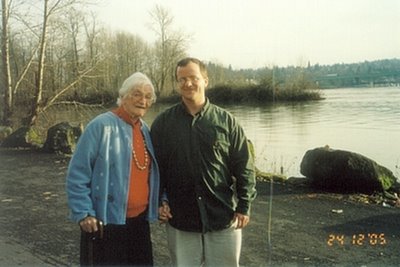
In such a setting, one can distill the essence of a ridge, with foliage only on the fir trees (17e):

Or one can put a ridge in the background and the trees not only without leaves but like large stick figures pointing out and up in front of them (17f):
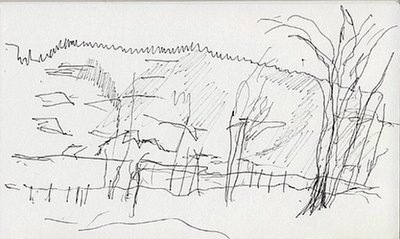
One can also add people and houses to the scene, giving it the trappings of civilization (17g):

Winter lays bare the inherent patterns in things, as beautiful as any abstract painting. Mom played with such patterns, seeing the dance of forms around us. These are as evident now as when she was doing her “pleine aire” oil paintings with her artist friends. Trees create strange patterns from the flowing water below and the light and air from above. Faces peer at us from their surfaces (17h):

The bridges create patterns of their own. Although most of the time only two are visible, there are actually four more in the vicinity, three on the Clackamas every quarter mile or so from its mouth, and one more over the Willamette, the old bridge to West Linn just behind the new one. Mom drew the these last two together one day, the big and functional with the old and graceful in a kind of dance and harmony of disparate structures, made visible with the shedding of the leaves that modulate their presence. A succession of ridges in the background completes the scene (17i):
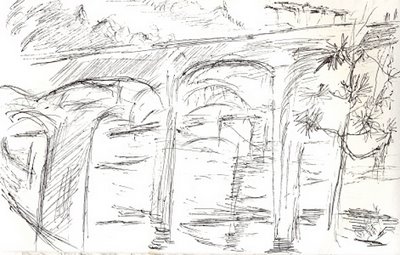
One nice thing about Oregon winters is that there are warmer days, too, when people are out enjoying nature. People walking their dogs make a good subject for a sketch, Mom found. To start with, let me show a couple of sketches Mom did before her stroke, probably in one of these riverside parks. First, we have a dog on a tight leash, but no person in view (17j). Another sketch has the leash and the person, her back to us, but no dog (17k). These are characteristic touches of Mom’s.


Now, in the winter of 2005-2006, she did a sketch that shows all together, and in fact two dogs, two leashes, and two dogs. Here they are dwarfed by the powerful landscape. One of the people is an adult, the other a child, and their dogs are getting to know each other up close (17l):

Another thing about winter in is that the days are not all shades of gray. The sky is occasionally blue and the many of the trees are evergreens. And although Mom didn’t attend her watercolor classes very faithfully that winter, she did occasionally liven up her pen and inks by adding watercolor to them. After she died, I found three examples. I had already scanned them as plain pen and inks, and I discovered later that she added a watercolor wash. Her pen and inks suddenly burst into color (18a-d):
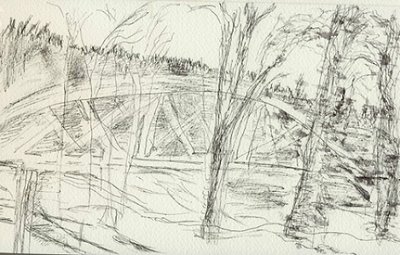



I suspect that Mom had in mind coloring these before she inked them, because she sketched them on stiff paper good for putting watercolors on. A third one, below was just as afterthought. I had done a print-out of a sketch called “The Island,” and she decided to try adding color, even though the paper wasn’t really suited to watercolors (18f-g):


Mom was lucky to get caregivers who would take the trouble to drive her to the river. I remember once Mom was having “problems” with a new one. I never could get a clear idea of what the problem was. She just didn’t trust her. Perhaps she wasn’t getting enough trips to the river! In any case, one day she called me and asked if I’d come early and take her “for a drive.” I agreed but said I could only take her as far as the Milwaukie Library, where I had to return some books and check out others. If she saw something to sketch on the way, such as the river there, it would be fine.
Heading to the library, she complained up and down about her caregiver and said she wanted her “fired.” She was really angry. “All she does is order me around,” she said. When we arrived I saw a magnificent Japanese style bush or low-growing tree right in front of a vacant parking place. I parked there and left her in peace, checking every so often to make sure she was ok. I finally said we’d be late for dinner if we took any more time. She did four drawings of that bush or tree in about an hour, each angrier than the one before. Let us look at the first three (18g-i):

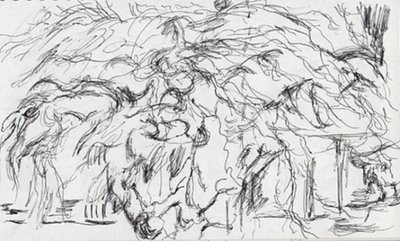

The second one is even fuller of heavy, angry lines than the first. And you can’t get a clear idea in either of them just how the tree connects to the ground. It just hangs there, like unfocused anger.with no clear cause. In the third one the lines are less dark and the connection to the ground is much clearer. Let us go on (18k):

In this last one the trunk is really clear-cut, the lines flow gracefully out, dark only where they should be, and the white space plays an active role, forming a kind of protective canopy. Drawing helped her get the anger out and bring her back to the world. Driving back to Rose Villa, she was as sweet and calm as could be.
As we later determined, Mom was having trouble sleeping, and she also was fighting a low-grade bacterial infection. The result was irritability and paranoia. Fortunately there are medications now that can help people sleep without making them drowsy the next day and without being addictive. With Mom, that and some penicillin worked like a charm. Within a week, the very same caregiver that had been intolerable had become a wonderful person.
There are various ways of drawing the "flood," of course. One way is with lots of dark lines (17a):

It can be made a little less intense (17b:

It can also be done more minimalistically (17c).

Actually, winter was a good time to do what fascinated Mom throughout her artistic life, the art of drawing just enough to convey the scene. Some of the trees are bare, clouds have given way to a dull overcast, and not many people or boats are about. A photo may suggest the appeal, taken at the end of December (17d). It is of Mom and her grandson Brandy, visiting from North Carolina, at Mom’s favorite spot. In warmer weather, fishermen stand at the point behind them, where the Clackamas and the Willamette meet. The I-205 bridge is barely visible in the background.

In such a setting, one can distill the essence of a ridge, with foliage only on the fir trees (17e):

Or one can put a ridge in the background and the trees not only without leaves but like large stick figures pointing out and up in front of them (17f):

One can also add people and houses to the scene, giving it the trappings of civilization (17g):

Winter lays bare the inherent patterns in things, as beautiful as any abstract painting. Mom played with such patterns, seeing the dance of forms around us. These are as evident now as when she was doing her “pleine aire” oil paintings with her artist friends. Trees create strange patterns from the flowing water below and the light and air from above. Faces peer at us from their surfaces (17h):

The bridges create patterns of their own. Although most of the time only two are visible, there are actually four more in the vicinity, three on the Clackamas every quarter mile or so from its mouth, and one more over the Willamette, the old bridge to West Linn just behind the new one. Mom drew the these last two together one day, the big and functional with the old and graceful in a kind of dance and harmony of disparate structures, made visible with the shedding of the leaves that modulate their presence. A succession of ridges in the background completes the scene (17i):

One nice thing about Oregon winters is that there are warmer days, too, when people are out enjoying nature. People walking their dogs make a good subject for a sketch, Mom found. To start with, let me show a couple of sketches Mom did before her stroke, probably in one of these riverside parks. First, we have a dog on a tight leash, but no person in view (17j). Another sketch has the leash and the person, her back to us, but no dog (17k). These are characteristic touches of Mom’s.


Now, in the winter of 2005-2006, she did a sketch that shows all together, and in fact two dogs, two leashes, and two dogs. Here they are dwarfed by the powerful landscape. One of the people is an adult, the other a child, and their dogs are getting to know each other up close (17l):

Another thing about winter in is that the days are not all shades of gray. The sky is occasionally blue and the many of the trees are evergreens. And although Mom didn’t attend her watercolor classes very faithfully that winter, she did occasionally liven up her pen and inks by adding watercolor to them. After she died, I found three examples. I had already scanned them as plain pen and inks, and I discovered later that she added a watercolor wash. Her pen and inks suddenly burst into color (18a-d):




I suspect that Mom had in mind coloring these before she inked them, because she sketched them on stiff paper good for putting watercolors on. A third one, below was just as afterthought. I had done a print-out of a sketch called “The Island,” and she decided to try adding color, even though the paper wasn’t really suited to watercolors (18f-g):


Mom was lucky to get caregivers who would take the trouble to drive her to the river. I remember once Mom was having “problems” with a new one. I never could get a clear idea of what the problem was. She just didn’t trust her. Perhaps she wasn’t getting enough trips to the river! In any case, one day she called me and asked if I’d come early and take her “for a drive.” I agreed but said I could only take her as far as the Milwaukie Library, where I had to return some books and check out others. If she saw something to sketch on the way, such as the river there, it would be fine.
Heading to the library, she complained up and down about her caregiver and said she wanted her “fired.” She was really angry. “All she does is order me around,” she said. When we arrived I saw a magnificent Japanese style bush or low-growing tree right in front of a vacant parking place. I parked there and left her in peace, checking every so often to make sure she was ok. I finally said we’d be late for dinner if we took any more time. She did four drawings of that bush or tree in about an hour, each angrier than the one before. Let us look at the first three (18g-i):



The second one is even fuller of heavy, angry lines than the first. And you can’t get a clear idea in either of them just how the tree connects to the ground. It just hangs there, like unfocused anger.with no clear cause. In the third one the lines are less dark and the connection to the ground is much clearer. Let us go on (18k):

In this last one the trunk is really clear-cut, the lines flow gracefully out, dark only where they should be, and the white space plays an active role, forming a kind of protective canopy. Drawing helped her get the anger out and bring her back to the world. Driving back to Rose Villa, she was as sweet and calm as could be.
As we later determined, Mom was having trouble sleeping, and she also was fighting a low-grade bacterial infection. The result was irritability and paranoia. Fortunately there are medications now that can help people sleep without making them drowsy the next day and without being addictive. With Mom, that and some penicillin worked like a charm. Within a week, the very same caregiver that had been intolerable had become a wonderful person.

0 Comments:
Post a Comment
<< Home